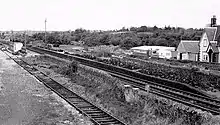Dublin and Belfast Junction Railway
Dublin and the Belfast Junction Railway (D&BJct) was an Irish gauge (5 ft 3 in (1,600 mm)) railway in Ireland. The company was incorporated in 1845 and opened its line in stages between 1849 and 1853, with the final bridge over the River Boyne opening in 1855. It linked the Ulster Railway (UR) from Belfast to Portadown and Dublin and Drogheda Railway (D&D) from Drogheda to Dublin, completing the missing link in the Dublin to Belfast main line.

History
On 6 January 1852 Portadown became a junction, when the northern section of the D&BJct was opened between Portadown and Mullaghglass about 1.5 miles (2.4 km) beyond Goraghwood. Bridging of valley near Bessbrook by construction of Craigmore Viaduct delayed the running of through trains to just north of Drogheda until 1852.[1] The Boyne Viaduct at Drogheda was not built until 1854–55, at a cost of £124,000, to the design of Sir John Macneill, who was the consulting engineer for the D&BJct.[2]
Route
The D&BJct line from Drogheda to Portadown connected the Ulster Railway's Armagh – Portadown – Belfast Great Victoria Street original line with the Dublin and Drogheda Railway's Dublin Amiens Street – Drogheda line, forming the main line between Dublin and Belfast.
Aftermath
In 1875, the D&BJct merged with the Dublin and Drogheda Railway (D&D), forming the Northern Railway of Ireland.[1] This was in turn one of the companies that amalgamated to form the Great Northern Railway of Ireland in 1876.
References
- Friel, Charles P. "Railways in Craigavon". Journal of the Craigavon Historical Society. 2 (2). Archived from the original on 25 October 2009. Retrieved 1 September 2009.
- Holohan, Michael. "Drogheda Port. A Detailed History". Drogheda Port website. Retrieved 1 September 2007.
Sources
- Ahrons, E.L. (1927). The British Steam Railway Locomotive 1825-1925. Amen Corner, London: Locomotive Publishing Co. OCLC 2329259. OL 6715902M.
- Ahrons, E. L. (1954). L. L. Asher (ed.). Locomotive and train working in the latter part of the nineteenth century. six. W Heffer & Sons Ltd.
- Hamond, Fred; Friel, Charles (December 2007). "13 Drogheda–Oldcastle Line". An Industrial Heritage Survey of Railways in Counties Monaghan and Louth (PDF). Monaghan CC & Louth CC (Report). Archived (PDF) from the original on 24 May 2019.